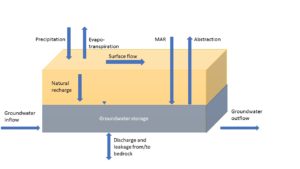Sustainable management of groundwater resources ensures self-sustaining use of aquifers and guarantees continuous supply for all groundwater users. This platform provides tools that help to balance water outtake from groundwater users with natural and artificial groundwater recharge and help to adjust components of the water balance system to outbalance deficits.
Worldwide, especially in urban areas, the demand for water is rising due to increasing population. Another threat to water resources is the changing climate which may change the rainfall patterns so that less natural groundwater recharge is generated. Specifically in arid and semi-arid areas that are already prone to little natural recharge an increase in water demand may easily tip over the local water balance and groundwater systems become over-exploited. This may lead to decreasing water tables and and in coastal areas to increasing salinization due to saltwater intrusion. Increasing water scarcity further intensifies the competition between water users creating inequity and potentially poverty to those who lose access to their water resources. Thus, it is important to install a water management system that balances the needs of all groundwater users with the potential groundwater recharge in order to generate a sustainable aquifer system. In case of water deficit adjustments need to be made that on the one hand guarantee reliable water supply for all groundwater users but on the other hand ensure sustainable long-term solutions.
Figure 1. Illustration of different components of the groundwater balance (including natural and anthropogenic components)
The tools in this section help to quantify the different components of the groundwater balance. This will enable the user to identify groundwater users and depict ways to decrease groundwater abstraction. It can also show the potential for increasing groundwater recharge (naturally and artificially) in order to outbalance groundwater deficits. Quantifying the effect of groundwater recharge on the groundwater resources had been conducted for stormwater harvesting in Australia (Clark et al., 2015). The study was able to show for how much of the regional water supply the MAR scheme could account for. Niazi et al. (2014) were able to show that the application of MAR was able to help conserve groundwater resources and to outbalance the water uptake from several groundwater users to some extent.
The following INOWAS tools can be used to assess and manage groundwater resources:
To select a suitable MAR method or a model set for the specific study area, the following tools can be used:
REFERENCES
- Clark, R., Gonzalez, D., Dillon, P., Charles, S., Cresswell, D., Naumann, B., 2015. Reliability of water supply from stormwater harvesting and managed aquifer recharge with a brackish aquifer in an urbanising catchment and changing climate. Environ. Model. Softw. 72, 117–125. doi:10.1016/j.envsoft.2015.07.009
- Niazi, A., Prasher, S., Adamowski, J., Gleeson, T., 2014. A System Dynamics Model to Conserve Arid Region Water Resources through Aquifer Storage and Recovery in Conjunction with a Dam. Water 6, 2300–2321. doi:10.3390/w6082300

